
DeSoto car cover is not just a piece of fabric tossed over the body for peace of mind. With classic DeSoto models known for their two-tone paint from the tailfin era, the right cover works like a filter for light and heat so both color blocks “age” at the same pace. Many owners in the United States share the same scene: the car sits half a day under a porch, one side catching slanting sun while the other stays in shade; months later, the dark tone has lost depth, the light tone shows a faint yellow cast near the chrome, and the dividing line between colors looks less crisp. From that uneasy moment, the story of protecting two-tone paint should start with understanding how fading really happens and building a habit of proactive covering from day one.
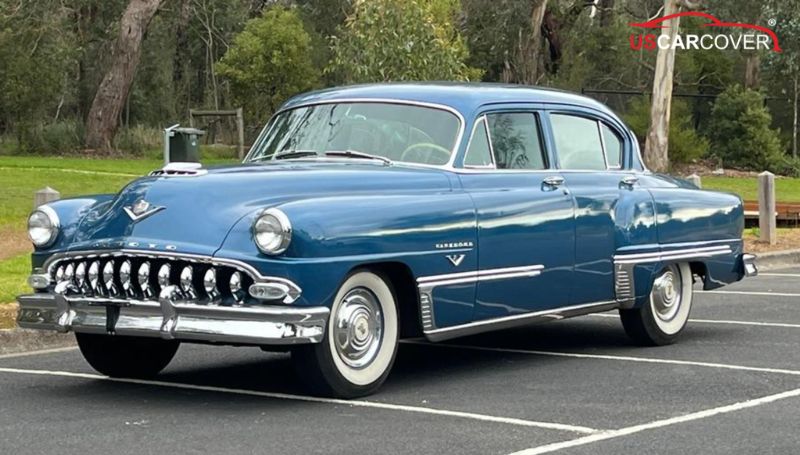
Related Articles: DeLorean car cover: block pollen, tree sap, and bird droppings, quick scratch
The aesthetic value of two-tone paint on DeSoto

Mention DeSoto and you picture America in the 1950s to early 1960s: Coral White with Turquoise, Gold next to Jet Black, Cream paired with Bronze, all “framed” by mirror-bright chrome strips and proud tailfins. The beauty of two-tone paint lies in calculated contrast. The upper block is often light and highly reflective so the body looks airy and elegant, while the lower block is warm or dark to add visual length and presence. When both tones stay in step, the car “speaks” clearly. But the moment each tone drifts a little in different directions, the whole composition feels off and the car looks older than its years.
Related Articles: How to Protect Datsun from Harsh Sun and UV: keep paint and interior looking new
Mechanisms of color shift: materials, UV, heat, and cumulative differences
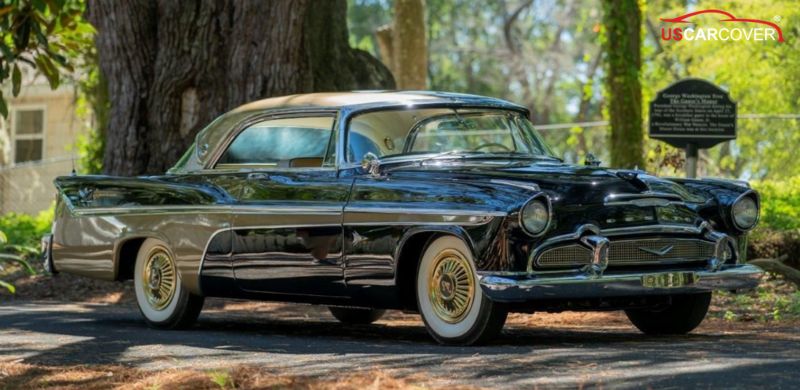
Two-tone paint on a classic does not drift because of one single cause. It is a sum of small forces. Light tones like white, cream, and pale yellow reflect well but pick up stains from sprinkler minerals, fine metallic dust, or overnight dew spots. Darker tones like blue, coral red, and black are sensitive to strong sunlight because the top polymer layer slowly weakens under UV and the depth of color disappears. When both tones live on the same body, they are attacked along two different “timelines.” On top of that, the dark block absorbs more heat than the light block right next to it, so the same panel can have hot and cool zones. Daily thermal expansion and contraction create micro stress that dulls the surface faster. Small differences repeated day after day turn into noticeable imbalance by the end of a season.
Related Articles: Daimler car cover: Long-term storage, quick drying, no musty odor, no veneer stains
Parking contexts in the U.S. that accelerate color shift
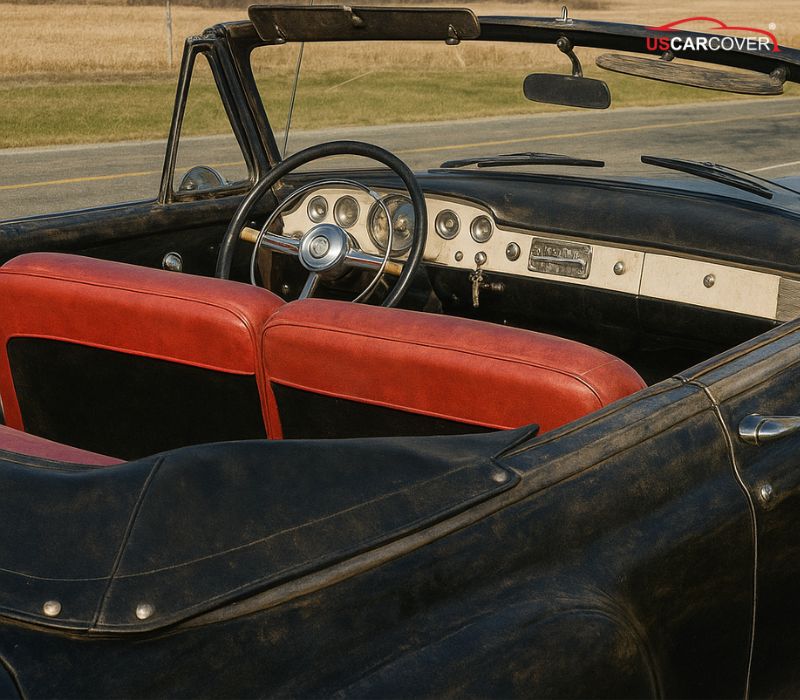
Real American parking situations make this story easy to see. In inland California or Arizona, a half-open carport lets afternoon sun strike one side while the other sinks into shade; after a few weeks, the sunlit dark block loses depth much faster than the light block. In Texas or Nevada, a late-evening sprinkler cycle leaves mineral halos on light tones; wiping them off quickly on a warm panel imprints micro haze that slowly changes the color. In New England, pollen and sap fall with every breeze; midday sun “bakes” those marks along the color break, especially near chrome edges. Along the coasts of Florida or Southern California, light ocean salt settles on bright trim at night, then morning sun reflects from the chrome onto the neighboring light tone and creates annoying “burned edges.” In the Pacific Northwest, long, cool humidity and heavy dew do not bring extreme UV, but they do leave water rings and musty odor that flatten the look of light tones fast if the surface is not allowed to breathe.
DeSoto body geometry and its impact on tone
The body shape of DeSoto adds another layer of difficulty. Large wraparound glass heats the cabin quickly and that heat radiates back into the panels around the glass. Thick chrome strips bounce sunlight onto adjacent light paint. Tall tailfins cast sharp-edged shade so a single panel can see two very different levels of sunlight. Body creases change the angle of light between the upper and lower blocks, so the two tones already receiving different energy now diverge even more. A proactive shield that “levels out” those differences is exactly what a correct DeSoto car cover provides.
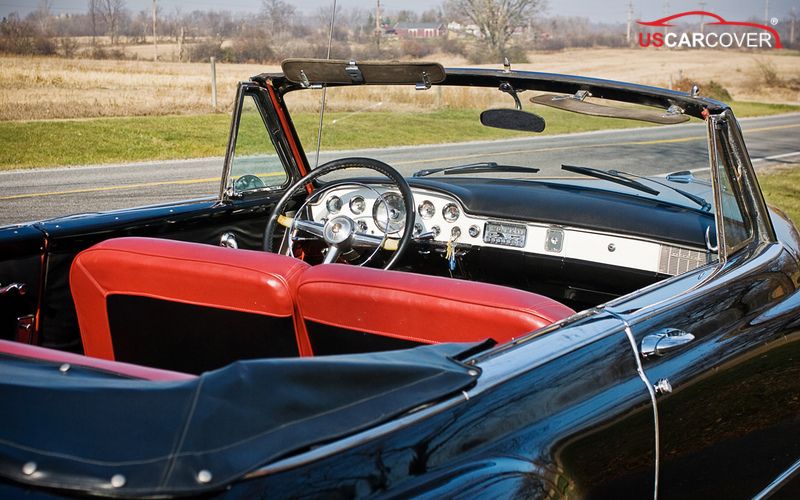
Related Articles: Citroen Car Cover: Cooling the car, protecting the interior, keeping the cabin cooler when parked outdoors
The role of DeSoto car cover in keeping both tones in sync

The key is that a DeSoto car cover works like a uniform filter for both light and heat. Once covered, UV no longer hits the car half bright and half muted. It is filtered to a relatively even level, and surface temperature drops evenly across both tones so the dark block is no longer much hotter than the light one. At the same time, pollen, sap, and bird droppings stop on the fabric rather than on the paint. When you lift the cover in the morning, most dust falls away with a simple shake. That means far fewer times you must touch the paint, and the risk of micro-scratches along the color break drops sharply. The real benefit comes from preventing problems before they start, not chasing them after they appear.
10 criteria to choose a DeSoto car cover to preserve color
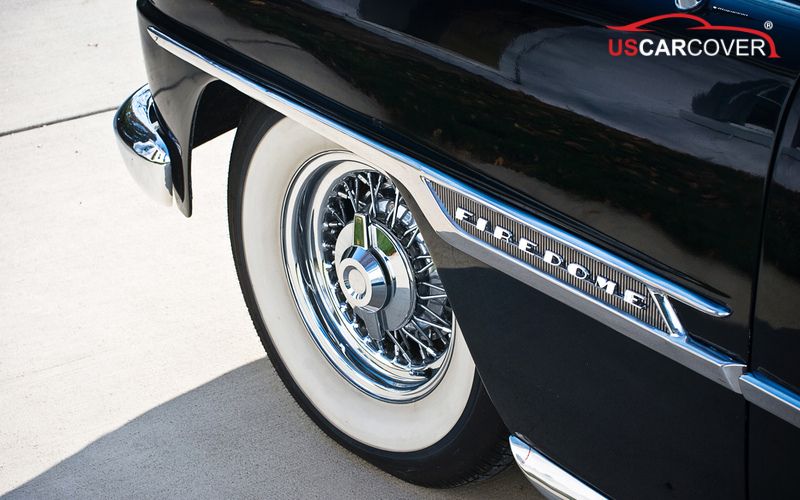
Choosing the right cover is not just about thickness. First, the outer face should be a light tone to reflect heat and it should include a stable UV barrier, because this is the first line that keeps both tones receiving similar energy. The fabric must breathe and dry quickly so it does not trap overnight moisture, which would imprint water rings and slight yellowing on the light tone within weeks. The liner must be very soft and light colored. A soft liner reduces friction during daily on-off use, while a light color helps you spot dirt early and avoid dye transfer in warm, humid conditions. Vehicle-specific fit is mandatory on a DeSoto with tailfins and lots of chrome. A slightly oversized universal cover may feel convenient, but the extra fabric will flap in the wind and rub right on the color break, leaving a dull track over time. Small details such as mirror pockets set correctly, gentle elastic hems, wide soft tie-down straps that distribute load, and louvered air vents at the shoulders or rear glass each serve a purpose. They keep the cover in place, reduce hot spots, and limit repeated contact points.

Related Articles: Chrysler car cover - Storm and wind protection: add a physical lock, stabilize form, stop ballooning that scuffs paint
Choose a car cover by U.S. climate regions to avoid color shift
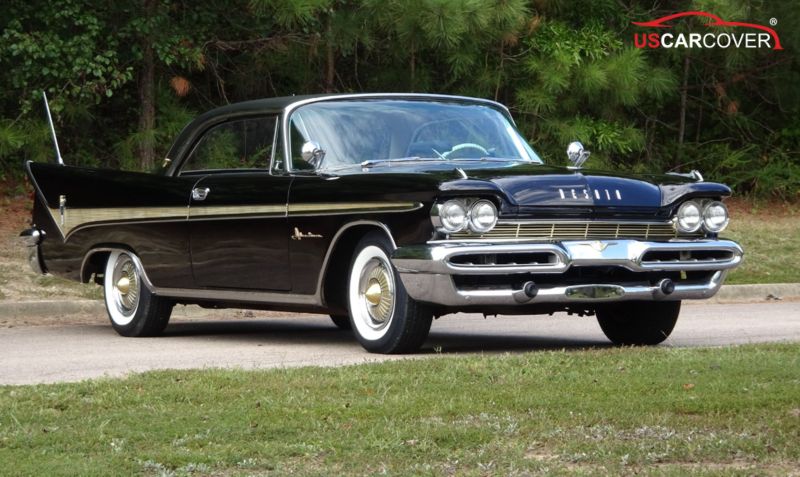
Looking by region, the same DeSoto may need a different configuration. In Arizona, Nevada, and inland California, the top priority is strong heat reflection and high UV resistance to lower temperature on both tones, with a close fit to reduce flapping in dry winds. In Texas, Florida, and the Gulf Coast, frequent sprinklers and salty humidity demand fast moisture release, easy washability, and vents with hoods that let hot air out but keep water from blowing in. In New England and the Midwest during spring pollen season, a low-stick outer face is golden because a quick morning shake clears the cover, and an ultra-soft liner makes daily cover on-off safe. In the Pacific Northwest, long humidity calls for sealed seams and rapid drying to avoid musty smell and water imprints. Along the Southern California coast, light salt haze can dull chrome. If you store the car for longer stretches, clean and dry the brightwork first and use a cover that washes and dries easily so you maintain it often.
Related Articles: Cadillac car cover: protect against dust and sand, tree sap, and animals, keep scratches away
Fitment by DeSoto body styles: easy-to-miss areas
Proper fit is always a challenge with DeSoto bodies. Two-tone sedans have multiple chrome bands. If the cover’s seam paths do not track those strips, the fabric will rub the color break in crosswinds. Convertibles need attention at the fabric top edge with snaps and seams. A snug pattern prevents the cover from vibrating and sanding those points. Tall tailfins require the right “dome” so you are not stretching fabric over the fin tip. Wraparound front glass needs very gentle elastic so no imprint appears at the glass corners. When ordering, provide year, body style, and tailfin height, then test-fit once to adjust mirror pockets and vents before long-term use.
The 90-second cover routine each time you park: quick, neat, and safe
The cover delivers full value only when paired with a short routine every time you park. Right after shutting off, spend about ninety seconds on a simple sequence. Shake dust off the glass edges and hood to remove hard particles before the fabric touches paint. Set the front hem at the nose emblem, draw the cover down the roofline, and seat the mirror pockets so everything is straight. Set the elastic hems evenly at four corners, smooth any folds, especially along the color break so water does not pool and the fabric does not rub there. Clip the wide soft straps so load is balanced, and on street parking run the plastic-coated cable under the car and lock it at the reinforced grommets. Finally, check the tailfin and chrome zones and make sure the vents face the right direction. Once the motions are familiar, covering takes even less time than flipping a sunshade.
Related Articles: Chevrolet car cover - Reduce “curious touching,” reflective edging for visibility, conceal the interior at night
Handle stains correctly without causing tone shift
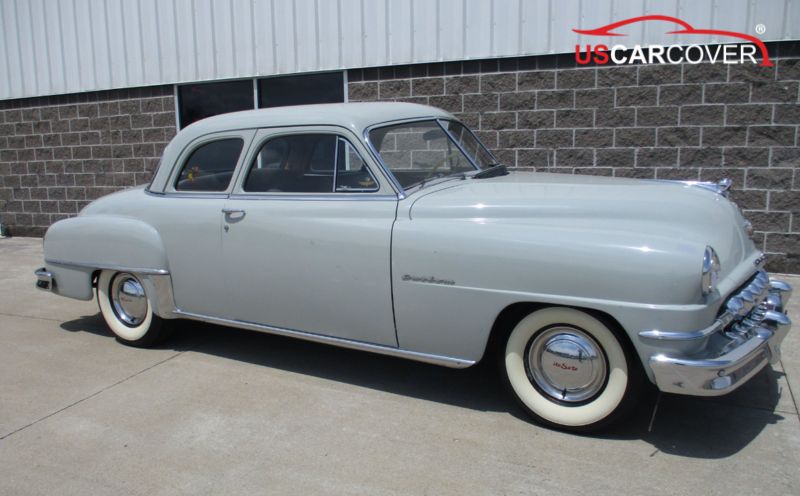
Even with careful covering, you will occasionally need to clean small spots. The golden rule is soften first, lift away second, and avoid dry scrubbing, especially at the color break. For pollen, mist cool water on the spot and pause one or two minutes so the natural wax in pollen releases, then lay a damp microfiber cloth down and lift in one direction. If a trace remains, do a quick wash with a mild pH soap and wipe straight, not in circles. For tree sap, lay a warm, damp cloth on the spot for three to five minutes to soften the resin, apply a small amount of a safe remover around the edge so the drop separates on its own, then sweep it off in one pass, rinse, and dry. For bird droppings, the sooner the better. Soften for a few minutes with a damp cloth, lift off, then rinse lightly. Do not let the sun bake it dry before you act. In all cases, move the cloth parallel to the color break to reduce the chance of cross-grain marks that reveal a shift.
Common mistakes that make the two tones diverge faster
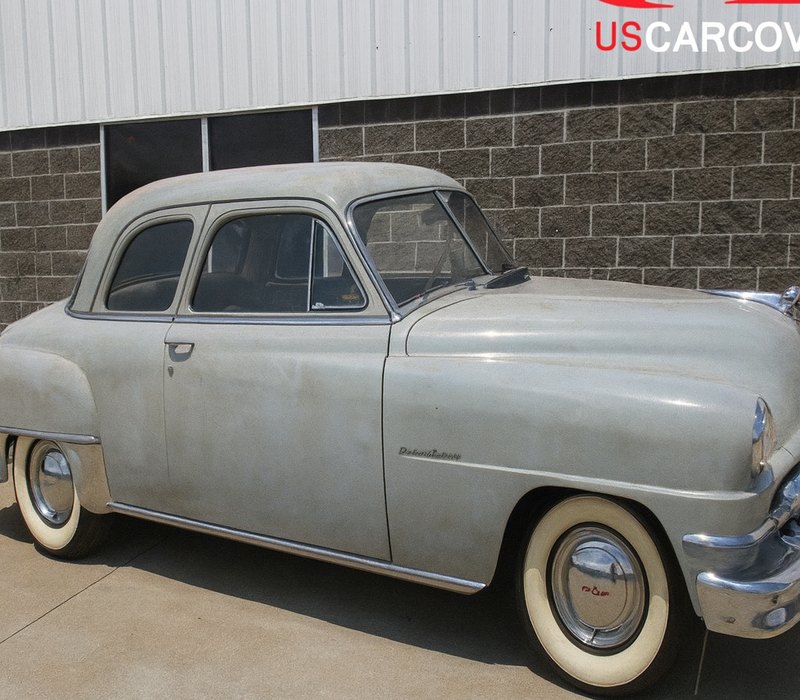
Small habits are the biggest accelerators of drift. Parking in uneven sun day after day without a cover almost guarantees the two tones “age” out of sync. Using a too-sealed, non-breathable cover traps moisture on the light tone and stamps water rings. Dry-wiping dust or sprinkler minerals on a warm panel grinds micro scratches and leaves yellowish halos over time. Picking at hardened sap drags across the grain and leaves a stubborn scar. Oversized universal covers flap and rub right on the color break. Dark-dyed liners risk color transfer in heat and humidity. Folding the cover while damp invites odor and stain spots. Skipping chrome care has a cost too, because dull trim reflects heat unevenly back onto the neighboring light tone.
Related Articles: Buick car cover: Prevent snow and ice buildup and minimize small hail damage
Maintain the car cover so it is always ready to protect the paint
A cover is only safe when it is clean, dry, and intact. Wash it on a schedule. If you park outdoors, every two to four weeks is reasonable; in a garage, about every six to eight weeks. Use a mild cleaner and dry completely in shade before folding it into a breathable bag. Keep the liner smooth by lint-rolling or light vacuuming so it does not turn into a micro-abrasive pad. Spend a few minutes each month checking seams, grommets, and straps and reinforce them before pollen or high-sun seasons. Before a new season, rehearse the cover routine so the motions are quick and gentle.
Related Articles: Checker car cover: mold resistant, odor control, quick-dry material that does not trap moisture
Keeping the two tones in harmony starts with the right cover and the right habits
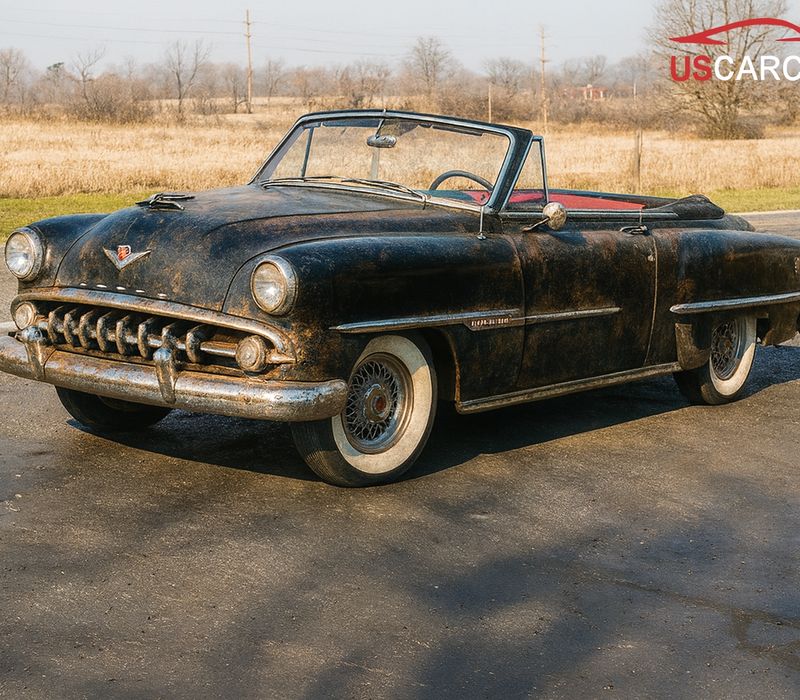
Once these steps become habit, results show quickly. The two color blocks keep their harmony instead of one pale and one heavy, chrome edges stay clear without “burned rims,” and the dividing line is crisp like day one. It all starts with one correct choice and a ninety-second routine each time you park. With a DeSoto car cover that has a light, UV-resistant, heat-reflective outer face, a multi-layer breathable and quick-drying fabric, a very soft light-colored liner, a vehicle-specific pattern that hugs tailfins and chrome, louvered vents, wide soft straps, and a plastic-coated underbody lock cable, you flatten the weather’s differences across both tones. Each morning when you lift the cover, your DeSoto appears not only clean and cool but also true in color, tone, and spirit, just like the day you fell in love with it.
